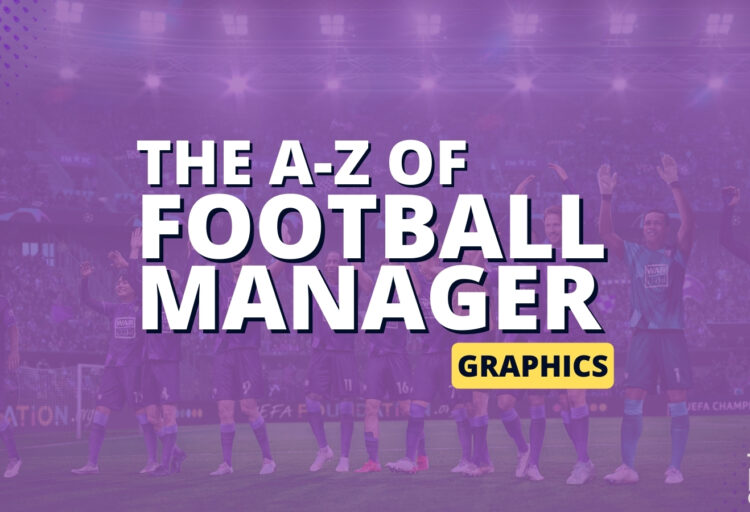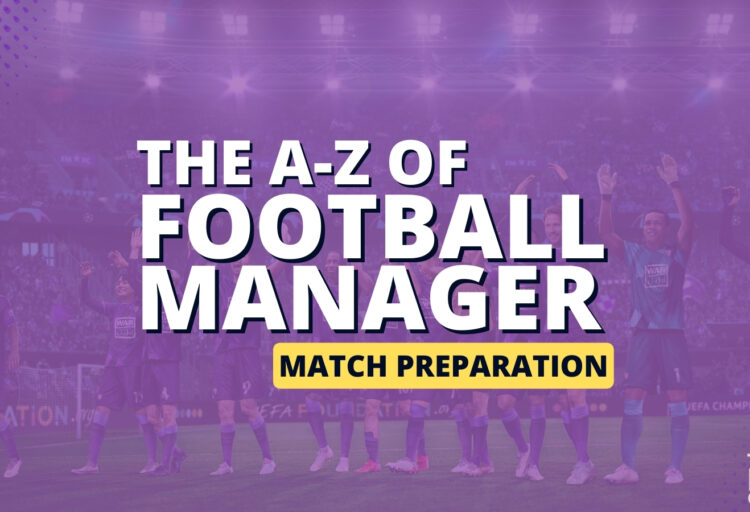T is for Football Manager Tactics by @GRMFM
Tactics are maybe the most important part of Football Manager. You install the game, load it up, create a save game with your favourite club and the first thing your assistant manager wants you to do is create your tactics.
You chose Tiki-Taka or Vertical Tiki-Taka from the pre-sets (who doesn’t want to dominate possession), opt for the 4-3-3 DM Wide formation (because that’s what Pep Guardiola would do), and tick all the team instructions that seem to be good for possession-based tactics. You continue through the pre-season, the season begins and… you start losing. A lot.
But why?
Didn’t you choose all the good stuff?
The tactics that all the great coaches lead their teams to trophies with?
Yes you did. But these coaches had great players and the right types of players to play these tactics. And you probably don’t.
But in this guide, I will show you how you can create tactics that work with whatever team you want to manage.
Step One: Team Analysis
Football Manager wants you to choose your style of play before you can choose a formation, but you have to work the other way around when creating a tactic. The first thing to do is to go into your squad planner and take a look on which positions your players can play and how many players you have for each position.

- Are there enough midfielders to play a 4-3-3?
- Do you have enough players that are capable of playing on the offensive wings, or would a front 2 be better because you have a couple good strikers?
- Is your squad filled with so many good centre backs that a back 3 would be better than a back 4?
The second step in your team analysis is to take a look at the player attributes.
- Are your wingers fast enough to base a huge part of your offensive success on them?
- Do your central midfielders have the skills to dictate the game in a more possession-based formation?
- And not less important, do some of your players maybe have just the right attributes to fill a positional hole in your squad?
I became (in)famous over the years for retraining players to totally different positions. Centre backs to defensive midfielders or even ball-winning midfielders, or vice versa, central midfielders and offensive wingers to wing-backs or full-backs…
Or maybe some of your players just have the wrong attributes for their best position. You’ve got a tall but slow offensive winger? Why not play him as Target Man or something similar? Your former star playmaker in the central attacking midfield got too slow? Why not pull him back one position and let him dictate the play from central midfield.
Step Two: How Can You Play
We already took a look at our players attributes in the previous step to find out what kind of players we have. But now we have to identify the squad’s strengths and weaknesses.
- Do the players have the technical and mental abilities that are needed for a possession-based style of play?
- Or maybe you have some hard-working midfielders with high aggression that would be perfect for counter-attacking tactics if you combined them with your fast offensive players.
- Are the centre backs fast enough for a tactic with high pressing, or do they move like a fridge and you risk conceding a good bunch of goals from long balls?
And how are your players compared to the rest of the league? To find that out, you have to take a look at the comparison screen in the squad planner.

Here, you can compare your squad with the rest of the league in all kinds of categories. One thing to look for are the strikers and the defenders. You might want to play a tactics with a lot of crosses because your striker is able to physically bully most centre-backs. Or you are playing in a lower league where defenders are rather slow and not that agile. Then you could consider playing a tactics with passes into spaces that your quick striker can exploit. Are your defenders slow compared to the attackers in your league? Play with a deeper defensive line.
Step Three: Formations, Roles and Spaces
You followed the previous steps and know how many and what kind of players you have for each position. Now it’s time to use this knowledge and put your tactics together, starting with the formation.
Let’s say you are lucky and have just the right players to play a 4-1-2-3 DM wide formation. You place the players on the field with the roles the pre-set gave you and change them to the players best suited roles, and you make your next mistake.
The players best roles aren’t necessarily the best roles for the tactics, because tactics are about covering and occupying spaces. Spaces your team isn’t covering in defence can be exploited by your opponent, and spaces your players don’t run into, while on offence, are spaces your opponent doesn’t have to care about.
And the attributes needed for different roles on the same positions aren’t that different. A ball-winning midfielder needs different attributes than a roaming playmaker. But the attributes needed for a roaming playmaker, mezzala, attacking central midfielder, et cetera are almost the same or are the same.
Take a look at the formation below:

- The centre-backs will stay back and cover against long balls
- The defensive midfielder is covering the space between midfield and the centre-backs
- The deep-lying playmaker is controlling the play from the left midfield
- The inside forward is running in the left offensive half-space in front of the deep-lying playmaker while the complete wing-back is overlapping the inside forward and occupying the left offensive space
- The attacking central midfielder is pushing in the right offensive half-space, while the right winger is attacking the right offensive space and the full-back is covering his back in midfield
- The deep-lying forward is dropping into midfield during possession and goes into the penalty area when the ball advances forward to the final third.
It would look pretty much like this:

Pretty good space coverage in offensive and defensive with a lot of movement to drag opposing players out of their positions.
Where are your players while in defence, where are they while on offence, and how are they moving around the pitch. These are 3 things you have to think about when choosing the player roles.
And you have to think about who you want to control your play and if you want a specific player to control the game. Playmaker roles are useful if you want to over play a specific player and let him find solutions against the opposing defence. But playmaker roles are attracting the ball, and your opponents are under pressure. You could force your build-up and attacking play to much in one direction and it’s easier for your opponent to stop your attacking play if he can focus on just one or 2 players.
And you shouldn’t use more than 2 playmakers in a tactics. Too many cooks spoil the broth, as the old saying goes. And don’t put the playmakers to close to each other. A deep-lying playmaker in defensive or central midfield and an advanced playmaker in central offensive midfield or a false 9 are okay. Two playmakers in central and/or defensive midfield, not so much. As well as a false 9 in combination with an advanced playmaker in the central attacking midfield.
But playmaker roles can be used to drag your opponents around and exploit their weaknesses. The formation I used in the example above is focusing the play over the left side, especially if you have a slower build-up. This will pull your opponents to this side and open spaces on the right side that can be exploited.
That’s what you could do if your opponent is weak on his left side. Force the ball to your left side, pull the opponents over and then switch the ball to your right side. The attacking central midfielder, the winger, and the striker have wider spaces where they can play 1 vs. 1 against your opponent’s weaker defenders.
Playmaker roles are Deep-Lying Playmaker, Regista, Roaming Playmaker, Advanced Playmaker, Trequarista, and False 9.
Finding the right roles can be tough for beginners, but the game will help you understand what the roles are doing on the pitch. All you need to do is click on the player role on the tactics screen. A pop-up window opens with pretty detailed tooltips about every role. And not just that. The popup window also contains animations where you can see how the different roles move on the pitch.

Step Four: Cats and Dogs
I have to quote Michael Cox and his great article in The Athletic:
Dogs are impetuous, energetic and desperate for action. They want to get the ball immediately by chasing after it, jumping towards it, scruffily getting it however they possibly can. They’ll hand over the ball and be keen to go again. Cats are sly, calculating and remain stationary before suddenly pouncing. They get the ball patiently by positioning themselves intelligently and then calmly throwing out a paw. They’ll keep the ball, so they don’t have to bother getting it for a second time.
But what does that have to do with our tactics in Football Manager. It means that you should always look for pairings between these two kind of players. Pairings between one player that is patiently holding his position and one player that is chasing the ball or the opposing player that has the ball. The most common descriptions for these two kind of players are “Sitter“ and “Runner“.
You can find these pairings all over the pitch when looking at the formation above. The complete wingback is the runner going forward, and the inside forward is holding the left half-space. On the right side, the winger is running forward, and the full-back is sitting in midfield to cover his back. The deep-lying playmaker is holding the midfield while the attacking central midfielder is running forward.
Always think about where your pairings are, who you want to run with, and who you want to sit with. You want to play a two-striker formation? You can play a technically gifted striker in the role of a deep-lying forward, let him connect the attack with the midfield and pair him with your fast-advanced forward or poacher that is running at the opposing defence.
Or let your tall but slow target man drop in the midfield and open spaces your fast shadow striker can then exploit.
The centre-backs in a back four are a bit different in Football Manager, and for beginners, it’s better to play with both players on defence. But you can play with a cover (sitter) and stopper (runner) pairing too.
And this pairing also exists in a back-three formation. The middle centre-back is the sitter, and a defensive midfielder can be the runner that is chasing for the ball in front of your defensive line.
And the outside centre-backs are acting like sitting full-backs. Because every formation you can imagine is just a 4-4-2 Diamond narrow with different player starting positions. But that’s a totally different topic about real-life football and philosophy.
Step Five: Team Instructions
Finally, just click one option in each segment and we are done. Or not.
The most common error beginners make, and I see it in almost every help request, is that people think that they have to pick one of the options in each segment. But what they don’t realise is that choosing nothing is also an option.
You don’t need to choose between focusing on playing down the wings or through the middle. You can choose nothing and let your players decide what to do. You don’t have to work the ball into the box OR hit early crosses. You can choose none of the options. You don’t need to tell your keeper to which players he should distribute the ball to. But you probably should, because keepers in Football Manager are incredibly dumb. But that’s another topic.
And you shouldn’t push your tactical approach in one direction. I don’t want to know how many times people asked for help because they couldn’t score, I’ve looked at their team instructions and they looked like this. Shorter passing, lower tempo, play out of defence, work ball into box, play for set pieces and often overlap on both sides.
Of course, you can’t score when the ball and your players move around the pitch so slowly that I could watch the entire Lord of the Rings trilogy before the ball moves into the opponent’s half. Don’t get me wrong. I’m not blaming anyone for not knowing and I’m not making fun of beginners. I was a beginner too, and I’ve made the same mistakes. And I’m still making mistakes. Football Manager is a very deep game, and you can always learn something new.
We used the squad analysis to find the best suitable formation(s) for our tactics. Then we thought about how best to cover and attack spaces and chose the player roles based on that. Now we just need to use our squad and league analysis to finish the tactics.
Your centre-backs are slow? Play with a deeper defensive and pressing line. Especially if you aren’t one of the better teams in the league. You have fast defenders and aggressive midfielders? You could try a high and intense pressing.
Your opponent is playing a 4-4-2 Diamond narrow and you have strong wingers? Try playing down the wings. You have a three-midfielder formation, and your opponent is playing a 4-4-2 flat or another two-midfielder formation? Maybe play through the middle.
Your midfielders don’t have great technical skills? You might want to play a bit slower and/or shorter.
And you can complement that with the right team mentality.
You are the underdog and/or don’t want to start offensively in the game? Start with cautious or balanced. You are the favourite or want to catch your opponent off-guard? Start with positive or attacking.
The only two mentalities you shouldn’t use are very attacking and very defensive, because these mentalities are really extreme. Even defensiveness can be to much if you aren’t the clear underdog.
Less is often more in Football Manager. Start with the team instructions you are sure you need. And add more after the next step, if needed.
Final Step: Watching the Match
Theory is often just theory, and you need to watch the game to fully understand your tactics and to see if it needs some tweaks. I’ve seen it so many times how people cry on stream because they don’t understand why their tactics aren’t working. While watching the match on key highlights or commentary only.
You need to watch the matches, at least on comprehensive highlights, when trying new tactics. Or watch the full match and replays of important scenes. Are the players moving like you want? Are the spaces covered? Are you passing the ball around too slowly? Where are you losing the ball?
You can’t figure these things out if you’re just watching a couple highlights. And for beginners, it’s no shame to save the game before a match and replay the match multiple times with different team instructions and/or roles.
Each opponent is different and different opponents will give you different results. But playing the same opponent gives you a better chance to see and learn which changes do what on the pitch.
I hope that the guide will help you to create your own tactics and that you’ve learned maybe a bit that will make you understand real football a bit better.
Maddux is a Football Manager player from Germany and has been playing Football Manager since 2013. Tactics is, by far, his favourite thing in Football Manager and he publishes tactics guides at www.meistertrainerforum.de as well as on other websites. You can contact him at the Meistertrainerforum or on Twitter under his handle, @GRMFM, where he is tweeting about Eintracht Frankfurt and other football-related stuff.
For previous A-Z entries, please visit: The A-Z of Football Manager.





Leave a Reply